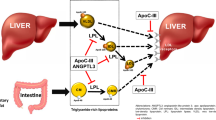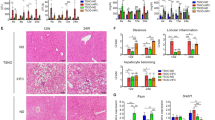Abstract
Hepatic lipase (HL) and endothelial lipase (EL) share overlapping and complementary roles in lipoprotein metabolism. The deletion of HL and EL alleles in mice raises plasma total cholesterol and phospholipid concentrations. However, the influence of HL and EL in vivo on individual molecular species from each class of lipid is not known. We hypothesized that the loss of HL, EL, or both in vivo may affect select molecular species from each class of lipids. To test this hypothesis, we performed lipidomic analyses on plasma and livers from fasted female wild-type, HL-knockout, EL-knockout, and HL/EL-double knockout mice. Overall, the loss of HL, EL, or both resulted in minimal changes to hepatic lipids; however, select species of CE were surprisingly reduced in the livers of mice only lacking EL. The loss of HL, EL, or both reduced the plasma concentrations for select molecular species of triacylglycerol, diacylglycerol, and free fatty acid. On the other hand, the loss of HL, EL, or both raised the plasma concentrations for select molecular species of phosphatidylcholine, cholesteryl ester, diacylglycerol, sphingomyelin, ceramide, plasmanylcholine, and plasmenylcholine. The increased plasma concentration of select ether phospholipids was evident in the absence of EL, thus suggesting that EL might exhibit a phospholipase A2 activity. Using recombinant EL, we showed that it could hydrolyse the artificial phospholipase A2 substrate 4-nitro-3-(octanoyloxy)benzoic acid. In summary, our study shows for the first time the influence of HL and EL on individual molecular species of several classes of lipids in vivo using lipidomic methods.










Similar content being viewed by others
Abbreviations
- CE:
-
Cholesteryl ester
- Cer:
-
Ceramide
- CerPCho:
-
Sphingomyelin
- DAG:
-
Diacylglycerol
- dko:
-
Double knockout
- EL:
-
Endothelial lipase
- ESI–MS:
-
Electrospray ionization-mass spectrometry
- FFA:
-
Free fatty acid
- HDL:
-
High-density lipoprotein
- HDL-C:
-
High-density lipoprotein cholesterol
- HL:
-
Hepatic lipase
- ko:
-
Knockout
- LPL:
-
Lipoprotein lipase
- LysoPtdCho:
-
Lysophosphatidylcholine
- NL:
-
Neutral loss
- NOB:
-
4-Nitro-3-(octanoyloxy)benzoic acid
- PakCho:
-
Plasmanylcholine
- PLA2 :
-
Phospholipase A2
- PlsCho:
-
Plasmenylcholine
- PtdCho:
-
Phosphatidylcholine
- PL:
-
Phospholipid
- sdLDL:
-
Small-dense low-density lipoprotein
- SRM:
-
Selective reaction monitoring
- TAG:
-
Triacylglycerol
- WT:
-
Wild-type
References
Brown RJ, Rader DJ (2007) Lipases as modulators of atherosclerosis in murine models. Curr Drug Targets 8:1307–1319
Ehnholm C, Greten H, Brown WV (1974) A comparative study of post-heparin lipolytic activity and a purified human plasma triacylglycerol lipase. Biochim Biophys Acta 360:68–77
Sanan DA, Fan J, Bensadoun A, Taylor JM (1997) Hepatic lipase is abundant on both hepatocyte and endothelial cell surfaces in the liver. J Lipid Res 38:1002–1013
Jaye M, Lynch KJ, Krawiec J, Marchadier D, Maugeais C, Doan K, South V, Amin D, Perrone M, Rader DJ (1999) A novel endothelial-derived lipase that modulates HDL metabolism. Nat Genet 21:424–428
Hirata K, Dichek HL, Cioffi JA, Choi SY, Leeper NJ, Quintana L, Kronmal GS, Cooper AD, Quertermous T (1999) Cloning of a unique lipase from endothelial cells extends the lipase gene family. J Biol Chem 274:14170–14175
Gonzalez-Navarro H, Nong Z, Freeman L, Bensadoun A, Peterson K, Santamarina-Fojo S (2002) Identification of mouse and human macrophages as a site of synthesis of hepatic lipase. J Lipid Res 43:671–675
Qiu G, Hill JS (2007) Endothelial lipase enhances low density lipoprotein binding and cell association in THP-1 macrophages. Cardiovasc Res 76:528–538
McCoy MG, Sun G-S, Marchadier D, Maugeais C, Glick JM, Rader DJ (2002) Characterization of the lipolytic activity of endothelial lipase. J Lipid Res 43:921–929
Fuki IV, Blanchard N, Jin W, Marchadier DH, Millar JS, Glick JM, Rader DJ (2003) Endogenously produced endothelial lipase enhances binding and cellular processing of plasma lipoproteins via heparan sulfate proteoglycan-mediated pathway. J Biol Chem 278:34331–34338
Dichek HL, Brecht W, Fan J, Ji Z-S, McCormick SPA, Akeefe H, Conzo L, Sanan DA, Weisgraber KH, Young SG, Taylor JM, Mahley RW (1998) Overexpression of hepatic lipase in transgenic mice decreases apolipoprotein B-containing and high density lipoproteins: evidence that hepatic lipase acts as a ligand for lipoprotein uptake. J Biol Chem 273:1896–1903
Ji Z-S, Dichek HL, Miranda RD, Mahley RW (1997) Heparan sulfate proteoglycans participate in hepatic lipase and apolipoprotein E-mediated binding and uptake of plasma lipoproteins, including high density lipoproteins. J Biol Chem 272:31285–31292
Zambon A, Deeb SS, Bensadoun A, Foster KE, Brunzell JD (2000) In vivo evidence of a role for hepatic lipase in human apoB-containing lipoprotein metabolism, independent of its lipolytic activity. J Lipid Res 41:2094–2099
Brown RJ, Lagor WR, Sankaranaravanan S, Yasuda T, Quertermous T, Rothblat GH, Rader DJ (2010) Impact of combined deficiency of hepatic lipase and endothelial lipase on the metabolism of both high-density lipoproteins and apolipoprotein B-containing lipoproteins. Circ Res 107:357–364
Escolà-Gil JC, Chen X, Julve J, Quesada H, Santos D, Metso J, Tous M, Jauhiainen M, Blanco-Vaca F (2013) Hepatic lipase- and endothelial lipase-deficiency in mice promotes macrophage-to-feces RCT and HDL antioxidant properties. Biochim Biophys Acta 1831:691–697
Han X, Gross RW (2005) Shotgun lipidomics: electrospray ionization mass spectrometric analysis and quantitation of cellular lipidomes directly from crude extracts of biological samples. Mass Spectrom Rev 24:367–412
Ishida T, Choi S, Kundu RK, Hirata K, Rubin EM, Cooper AD, Quertermous T (2003) Endothelial lipase is a major determinant of HDL level. J Clin Invest 111:347–355
Bligh EG, Dyer WJ (1959) A rapid method of total lipid extraction and purification. Can J Biochem Physiol 37:911–917
Han X, Gross RW (2001) Quantitative analysis and molecular species fingerprinting of triacylglyceride molecular species directly from lipid extracts of biological samples by electrospray ionization tandem mass spectrometry. Anal Biochem 295:88–100
Ford DA, Monda JK, Brush RS, Anderson RE, Richards MJ, Fliesler SJ (2008) Lipidomic analysis of the retina in a rat model of Smith–Lemli–Opitz syndrome: alterations in docosahexaenoic acid content of phospholipid molecular species. J Neurochem 105:1032–1047
Bowden JA, Shao F, Albert CJ, Lally JW, Brown RJ, Procknow JD, Stephenson AH, Ford DA (2011) Electrospray ionization tandem mass spectrometry of sodiated adducts of cholesteryl esters. Lipids 46:1169–1179
Quehenberger O, Armando A, Dumlao D, Stephens DL, Dennis EA (2008) Lipidomics analysis of essential fatty acids in macrophages. Prostaglandins Leukot Essent Fatty Acids 79:123–129
Essaji Y, Yang Y, Albert CJ, Ford DA, Brown RJ (2013) Hydrolysis products generated by lipoprotein lipase and endothelial lipase differentially impact THP-1 macrophage cell signalling pathways. Lipids 48:769–778
Petrovic N, Grove C, Langton PE, Misso NLA, Thompson PJ (2001) A simple assay for a human serum phospholipase A2 that is associated with high-density lipoproteins. J Lipid Res 42:1706–1713
Verhoeven AJM, Neve BP, Jansen H (2000) Intracellular activation of rat hepatic lipase requires transport to the Golgi compartment and is associated with a decrease in sedimentation velocity. J Biol Chem 275:9332–9339
Ben-Zeev O, Doolittle MH (2004) Maturation of hepatic lipase: formation of functional enzyme in the endoplasmic reticulum is the rate-limiting step in its secretion. J Biol Chem 279:6171–6181
Bamji-Mirza M, Sundaram M, Zhong S, Yao EF, Parks RJ, Yao Z (2011) Secretion of triacylglycerol-poor VLDL particles from McA-RH7777 cells expressing human hepatic lipase. J Lipid Res 52:540–548
Erickson B, Selvan SP, Ko KWS, Kelly K, Quiroga AD, Li L, Nelson R, King-Jones K, Jacobs RL, Lehner R (2013) Endoplasmic reticulum-localized hepatic lipase decreases triacylglycerol storage and VLDL secretion. Biochim Biophys Acta 1831:1113–1123
Hegele RA, Little JA, Vezina C, Maguire GF, Tu L, Wolever TS, Jenkins DJ, Connelly PW (1993) Hepatic lipase deficiency. Clinical, biochemical, and molecular genetic characteristics. Arterioscler Thromb 13:720–728
Ridgway N, Dolphin PJ (1984) Lipoprotein lipase-mediated sequestration of long-chain polyunsaturated triacylglycerols in serum LDL from normal and hypothyroid rats. Biochim Biophys Acta 796:64–71
Nilsson A, Landin B, Schotz MC (1987) Hydrolysis of chylomicron arachidonate and linoleate ester bonds by lipoprotein lipase and hepatic lipase. J Lipid Res 28:510–517
Gauster M, Rechberger G, Sovic A, Hörl G, Steyrer E, Sattler W, Frank S (2005) Endothelial lipase releases saturated and unsaturated fatty acids of high density lipoprotein phosphatidylcholine. J Lipid Res 46:1517–1525
Rosengren B, Jönsson-Rylander A-C, Peilot H, Camejo G, Hurt-Camejo E (2006) Distinctiveness of secretory phospholipase A2 group IIA and V suggesting unique roles in atherosclerosis. Biochim Biophys Acta 1761:1301–1308
Stewart RH, White H (2011) The role of lipoprotein-associated phospholipase A2 as a marker and potential therapeutic target in atherosclerosis. Curr Atheroscler Rep 13:132–137
Acknowledgments
This work was supported in part by an IgniteR&D grant from the Research & Development Corporation of Newfoundland and Labrador (R.J.B.), a Discovery Grant from the Natural Sciences and Engineering Research Council of Canada (R.J.B.), a National Scientist Development Grant (#11SDG7210077) from the American Heart Association (W.R.L.), National Institutes of Health Grants HL-022633 and HL-055323 (D.J.R.), and National Institutes of Health Grants HL-074214 and HL-111906 (D.A.F.). The authors wish to thank Ms. Catherine Wright (University of Washington, Seattle, WA, USA) for advice with statistical analyses.
Author information
Authors and Affiliations
Corresponding author
Electronic supplementary material
Below is the link to the electronic supplementary material.
About this article
Cite this article
Yang, Y., Kuwano, T., Lagor, W.R. et al. Lipidomic Analyses of Female Mice Lacking Hepatic Lipase and Endothelial Lipase Indicate Selective Modulation of Plasma Lipid Species. Lipids 49, 505–515 (2014). https://doi.org/10.1007/s11745-014-3907-6
Received:
Accepted:
Published:
Issue Date:
DOI: https://doi.org/10.1007/s11745-014-3907-6




